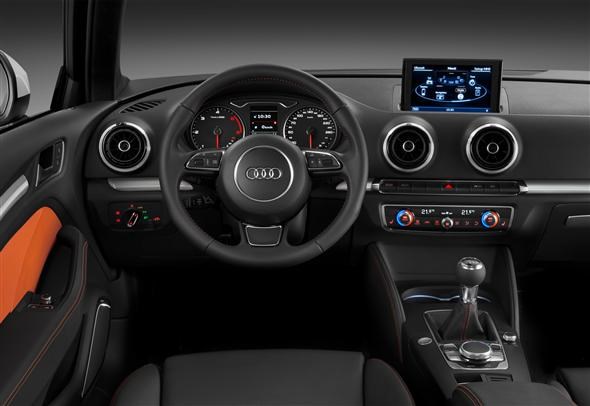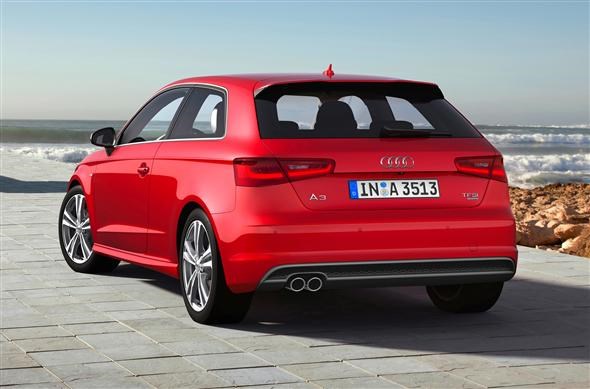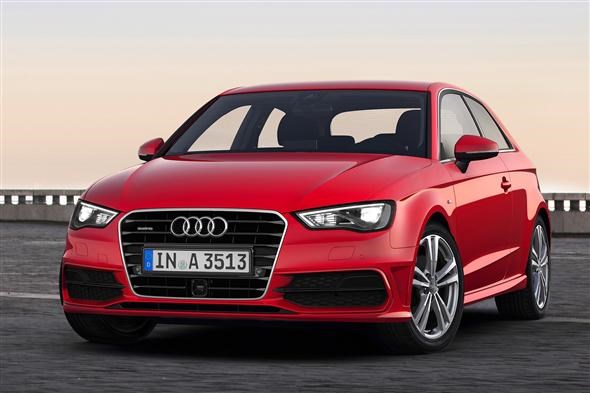Junior executives looking at their next fleet car could do a lot worse than considering the all-new Audi A3. It is a sensible car with a range of cost efficient engines, running costs are reasonable and you get to own a car with a prestige badge.
Is the Audi A3 better than a BMW 1 Series or a Volvo C30?
Design-wise the A3 looks a lot sharper than the previous generation, from the striking front end with the daytime running lights to the sporty rear and LED taillights. Audi has made the car 12mm wider and the wheelbase is 23mm longer but the car itself is no longer overall. This means that it has a larger boot (an increase of 15 litres over the old car) and there is more space in the cabin for passengers than before.
On the road we drove the 148bhp 2.0-litre diesel. It can complete the benchmark sprint from zero to 62mph in 8.6 seconds and has a top speed of 134mph. Mated to a six-speed manual gearbox the engine is lively and makes overtaking manoeuvres on B roads simple.
The Audi A3 behaves well when driven enthusiastically. Twisty B roads are enjoyable as the A3 has plenty of front-end grip when cornering. The A3 is not as fun to drive, however, as a BMW 1 Series. It lacks steering feel and feedback. The Audi’s ride is comfortable, though – the standard suspension is not too firm or too wallowy making this version ideal for long motorway trips.
Comfort levels are excellent in the Audi A3. The front seats are well bolstered and the side supports are of a decent size, giving good support when cornering enthusiastically. Road, wind and tyre noise are minimal since the interior is well insulated. While the cabin is driver focused, the switchgear feels solid and well-made and the plastics on the dash are soft to touch. The handbrake has been replaced by a parking brake – this frees up space in the central console but may not be to everyone’s taste.
Boot space has increased by 15 litres over the previous generation to 365 litres with the rear seats in place. Fold the split-folding seats flat and the load space increases to 1,100 litres. Compare this to its main rival, the BMW 1 Series, and you will find that the A3 has more load space with the rear seats up. However, the BMW does trump the Audi by 100 litres when the seats are folded flat.
For company car drivers the A3 makes good business sense. One of the biggest expenses for any driver is fuel. Choose this version of the A3 and you will benefit from a claimed 68.9mpg on average. More important is the emissions figure: 106g/km of CO2. This places the car in to the 16% Benefit-in-Kind band. Combined with a p11d value of around £22,000, the Audi A3 is good value on company car tax. For a 20% tax payer it will cost £55 per month, while a 40% tax payer will be charged £110.
The new Audi A3 may be a little understated when it comes to its design. However when it comes to making a sensible choice for a fleet driver this car ticks all the boxes.


Also consider
Enthusiast will choose this car for its fun factor. However, it also makes sense thanks to a good range of fuel-efficient engines.
The premium CT200h offers extremely low running costs thanks to its Toyota Prius-derived hybrid powertrain.
Looks-wise, it has the trademark upside-down triangular grille and the sculpted bonnet of the Mito and the 8C Competizione and with the new TCT semi-auto gearbox it has lower emissions than before.





